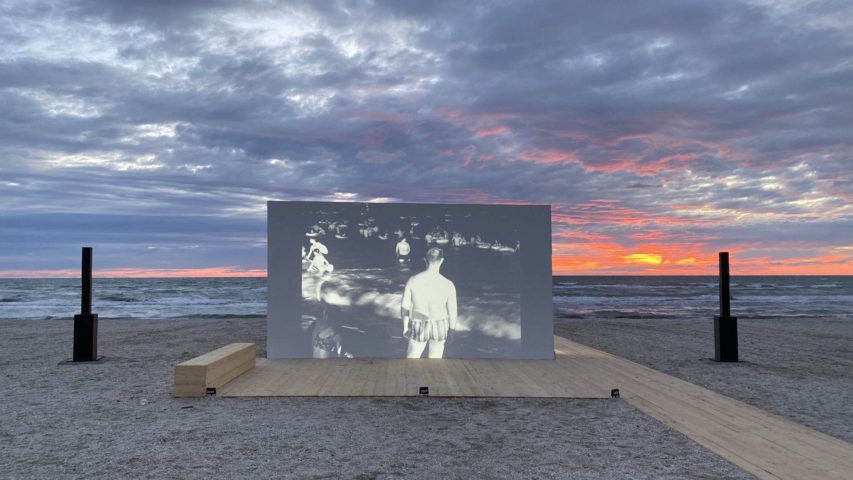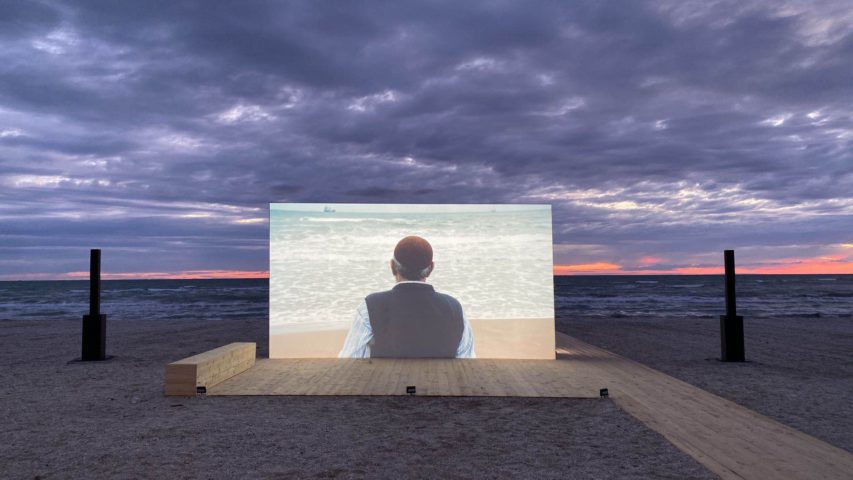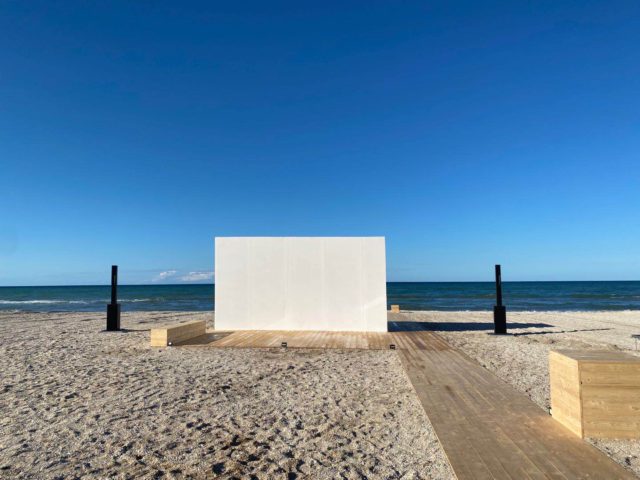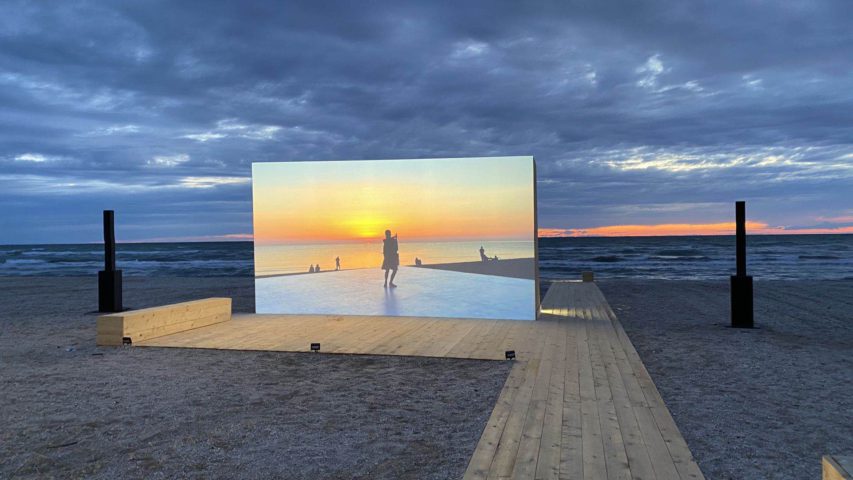







Seascape/Borders a selection for Demanio Marittimo 2020 by Davide Quadrio
Date: 2020 July 17th, 18:00-6:00 (next day)
Venue: Marzocca di Senigallia, Lungomare Italia
Participated artists: Olivo Barbieri, Yto Barrada, Sophie Calle, Soundwalk Collective, Lawrence Abu Hamdan, Joāo Penalva, Alessandro Sciarroni, Fabrizio Terranova, and Yang Zhenzhong
Curator: Davide Quadrio
For ten years I have been contributing to the Demanio in various ways, seeing it growing into an alternative space, a locus of the meeting of minds, an unexpected gathering, an ephemeral moment in time: on the seaside, between the landmass and the Adriatic Sea. While being away from the shores for the majority of the year, congregating on this beach in July is a moment to celebrate a Ulysses-like return to Ithaca.
For this edition, which occurs to be the tenth anniversary of this adventure, I wanted to create a narration which debuted from the Demanio’s presentation of Olivo Barbieri’s work, Seascape #1 Night, China Shenzhen 05, and connects the shores of Shenzhen to the white stage built last year to welcome Alessandro Sciarroni’s performance, Turning. In between those, I built a selection of exceptional contributions by artists from various places throughout the complex Eurasian continent: each piece creates a poetic sub-text of the seascape, where borders are fluid and the limits are not only on the surface but also deep in the abyss, or at the summit of the mountains that connects and separate the far east to the Mediterranean sea. The exploration of Eurasia starts with Joāo Penalva’s lullaby, The White Nightingale where the bridge and the river that flows through Bristol is here as a great metaphor of the danger of the water, the place of no return, the quintessence of the adventure. Followed by Yang Zhenzhong, I Will Die, 2000 (on going) that with a simple camera trick shows the fragility of human beings, their existence in this world, reminding all of us of our transience. Sophie Calle, Voir la mer, 2011, presenting the sea from the Istanbul side, from Asia back to Europe, as she describes: “I asked them to look out to the sea and then to turn back towards me to show me these eyes that had just seen the sea for the first time”. This simple exercise creates a black-out, a short-circuit of sort, opening humanity to the bliss of the infinite water. Soundwalk Collective, “Peradam” presents the new short film of the upcoming album. Premiering here for the Italian public is a magical quest written by Patty Smith that travels through the Himalayas, researching for the magical crystal of wisdom, peradam. Joāo Penalva, Kapitän, 2004 is a short and almost abstract piece with a boy reading a boat, describing each piece of the boat as if he was the captain of it, an intrepid and adventurous pirate of the undiscovered waters. Yto Barrada, Hand-me-downs, 2011, presents a sea of memories, a constructed fictional storytelling of archival images of other people and other stories, that brings us the uncertainty of history and the complicated implications that go along with it. Lawrence Abu Hamdan, Wall Unwalled, 2018, closes the selection and walls the narration in the contemporary drama of human divisions, constructed realities and questionable political decisions. The narration is personal, staged, mesmerizing, with a drumming rhythm that accompanies the funeral-like procession of our recent global history: no one is spared. Ideally bringing us into a present-future of hope and conscious responsibility the lullaby by Fabrizio Terranova, Camille, (extracted from Donna Haraway: Story Telling for Earthly Survival, 2016) narrates of humans and totemic animals combining DNA and sharing a physical and psychological mutual respect and responsibility: a contemporary post-apocalyptic “Song of the Songs”. Finally, the end of the selection is the integral footage of the performance by Alessandro Sciarroni, Turning, Senigallia version 2019. A ritual of life, at the dawn of the new day, an ode to hope and the opening to new possibilities, visions beyond time and space searching for alternative futures and a humanity that is difficult to embrace. Each piece presented is a piece of a soul, a poetic note, a comma, a fragile hiatus, a pause to watch and absorb, a moment stolen from the unstoppable Life.
About the artworks
Seascape #1 Night, China Shenzhen 05
black and white, 10 minutes
Joāo Penalva, The White Nightingale, Bristol / 2005
Single video projection 42 minutes, colour,
Joao Penalva’s film The White Nightingale presents a forensic-like exploration of the bed of the River Avon under the Clifton Suspension Bridge, one of Bristol’s primary icons and the subject of many stories and myths. This geographical place becomes the backdrop for a fairytale of sort, a lullaby, a sirens’ song that is both beautiful and scary. This occasion becomes a way for Penalva to explore the drama of searching for the truth and beauty, it becomes a metaphor for the human quest of knowledge and peace.
Yang Zhenzhong, I Will Die, 2000 (on going)
Single channel video edited in Italian and French from original multi-channel video installation with Chinese, English, German, Japanese, Korean, French, Dutch, Spanish, Arabic, Italian, each part 7-20 min, created 2000-2006, installation shoots at http://www.yangzhenzhong.com/eng/zhanlan/2007-venice/index.htm
Yang Zhengzhong became famous in 2000 with his half-hour video “(I Know) I Will Die” that features short sequences in which a series of people speak the phrase “I will die” to the camera. It was included as a multi-channel projection at the 2007 Venice Biennale to great acclaim. It is a disconcerting, soberly presented film that confronts the viewer with a simple, general and yet so overpassed existential question.
This work has 10 versions shot from different locations:
Chinese-Shanghai & Hangzhou, 2000; French-Brussels, 200, Dutch-Brussels, 2001
Korean-Seoul, 2001, German-Hannover/Braunschweig, 2002, Japanese-Tokyo, 2002, English-San Diego, 2003, Spanish-Tijuana, 2003, Arabic- Beirut, 2005
Italian-Roma, 2005
Sophie Calle, Voir la mer, 2011
A single channel film edited for the occasion from fourteen digital films with color and sound, installation. Director of photography: Caroline Champetier.
There is nothing more perfect that the description that Sophie Calle gives to this work.
“In Istanbul, a city surrounded by the sea, I met people who had never seen it. I filmed their first time. I took them to the Black Sea. They came to the water’s edge, separately, eyes lowered, closed or masked. I was behind them. I asked them to look out to the sea and then to turn back towards me to show me these eyes that had just seen the sea for the first time.” Full stop.
SOUNDWALK COLLECTIVE with Patti Smith, PERADAM (2020)
Dur. 07.46
From the album
PERADAM
Featuring Anoushka Shankar, Tenzin Choegyal, Charlotte Gainsbourg
Released September 4th, 2020
PERADAM takes as its entry point RENÉ DAUMAL’s early 1940s novel Mount Analogue: A Novel of Symbolically Authentic Non-Euclidean Adventures in Mountain Climbing, in which the French writer, critic and poet mapped a metaphysical journey to “the ultimate symbolic mountain” in search of meaning. In it, Daumal introduced the idea of the “peradam”, a rare, crystalline stone – harbouring profound truths – that is only visible to seekers on a true spiritual path.
Directed by STEPHAN CRASNEANSCKI
Editing and Visual Collage: JENN RUFF
Produced by Soundwalk Collective for Bella Union
All music produced by Soundwalk Collective in Rishikesh, Varanasi, Paris and NYC in collaboration with LEONARDO HEIBLUM
Text written by Patti Smith, copyright / © (2020) (Patti Smith)
Mix and additional production: RUSSELL ELEVADO at Electric Garden in New York
Mastering by NOEL SUMMERVILLE, London
With the kind of support of the ANALOGUE FOUNDATION
www.analoguefoundation.com
Joao Penalva, Kapitän, 2004
Video projection 13’ 28’’, colour, sound
It is nine o’clock in the evening.
We are in present-day Germany.
A boy, nine or ten years old, reads in bed under the blankets with a pocket light.
From his bedroom, he can hear the distant noises of a kitchen being tidied up, creaking floorboards, wind chimes, and the sound of a television set.
Andrei Tarkovsky’s film, Ivan’s Childhood (1962) is being broadcast, too late for children of his age to see. Ivan is a Russian orphan boy behind enemy lines during World War II, joining the Resistance to avenge the death of his parents.
The boy reads the list of all the parts of a three-mast ship.
He imagines himself as the captain.
He sails to mysterious islands over stormy seas, and falls asleep.
Yto Barrada, hand-me-downs, 2011
14 minutes
‘Hand-Me-Downs’ is a film in which Barrada investigates the history of her own family. She tells sixteen small stories, most of which take their point of departure in experiences she had as a child. The soundtrack of the film is accompanied by old French film shots of a period from1927-31. Barrada edits it all together in order for the sound to fit the pictures in places. As a viewer, you gradually become aware that not everything is what it seems. The narratives of the voice-over, at first trustworthy and confidence-inspiring, do not sit well with the accompanying film clips, while the stories told are often too incredible to be true.
Lawrence Abu Hamdan, Wall Unwalled, 2018,
21 minutes
In the year 2000, there was a total of fifteen fortified border walls and fences between sovereign nations. Today, physical barriers at sixty-three borders divide nations across four continents. As these walls were being constructed, millions and millions of invisible cosmic particles called muons descended into the earth’s atmosphere and penetrated meters deep, through layers of concrete, soil and rock. Scientists realized that these deep penetrating particles could be harvested, and a technology could be developed to use their peculiar physical capacities to pass through surfaces previously impervious to X-Rays. Muons allowed us to see for the first time the contraband hidden in lead-lined shipping containers and secret chambers buried inside the stone walls of the pyramids. Now, no wall on earth is impermeable. Today, we’re all wall, and no wall at all.
Walled Unwalled presents an interlinking series of narratives derived from legal cases that revolved around evidence that was heard or experienced through walls. It consists of a series of performances reenactments and a monologue staged inside a trio of sound effects studios in a former GDR state run radio station.
Dir, Writer, Performer Lawrence Abu Hamdan
Producer: Jarred Alterman & Lawrence Abu Hamdan
Fabrizio Terranova, Camille, from Donna Haraway: Story Telling for Earthly Survival, 2016.
Donna Haraway is a prominent scholar in the field of science and technology, a feminist, and a science-fiction enthusiast who works at building a bridge between science and fiction. Brussels filmmaker Fabrizio Terranova visited Donna Haraway at her home in California, living with her – almost literally, for a few weeks, and there produced a quirky film portrait. The film that comes out is a lyrical portrait of a unique figure in the philosophical field and the narrative that Terranova creates in this self-portraiting storytelling by Donna Haraway, is a unique style, almost a new genre that keeps the viewer on the tip of the chair, captured by images so naturally simple yet opening into a world of sci-fiction. And the result is a precious commentary of the world we should live in, not now but just few steps away. A testament and an ode to the power of the regenerating of our planet and hopefully of human beings always at the verge of suicide yet capable of unexpected redemptions.
Alessandro Sciarroni, Turning
Senigallia version 2019
During the experience of the European project Migrant Bodies (2014-2015), Alessandro Sciarroni developed the idea of a new and deeply germinal performative practice. Starting from the observation of the migration phenomenon of some animals that at the end of their life come back to reproduce and die in the very same place they were born; the artist elaborates on the concept of turning. The English term is translated and represented on stage in a literal way, through the action of the body rotating around its axis, and it develops into a psychophysical and emotional journey, an endurance dance recalling one of the meanings of turning as evolving and changing.
In TURNING_migrant bodies version, Sciarroni is back to the first person action, training for several months in the practice that allows the body to spin for an undetermined time without losing balance. The duration of the performance and the gradual increase of the rhythm create a hypnotic bond between performer and viewer. The spinning of Sciarroni on the Adriatic Sea shore ideally turns the wheel of time, hence showing our humanity as a continuous struggle to be, to leave traces and inevitably come back repeatedly to the same place between beginnings and ends. This film is the recording of his performance for Demanio 2019 at dawn, on the sea side.